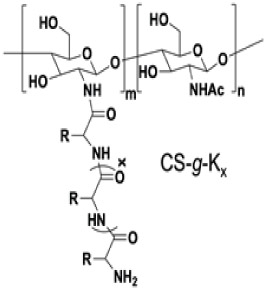Table 3.
Antimicrobial and hemolytic activity of polylysine-grafted chitosan; adapted with permission from Li et al.,22 copyright © WILEY-VCH Verlag GmbH & Co. KGaA, Weinheim.

| |||||||
|---|---|---|---|---|---|---|---|
| MIC (μg/mL) | HC50 (μg/mL) |
Selectivityb (HC50/MIC) |
|||||
| E. coli |
P.
aeruginosa |
S.
aureus |
|||||
| Increasing AMP length and charge |
|
CS-g-K1 | 80 (37)a | 80 (37) | 160 (73) | >50000 | >625 |
| CS-g-K3 | 20 (15) | 20 (15) | 40 (29) | >50000 | >2500 | ||
| CS-g-K9 | 10 (8.8) | 20 (17) | 20 (17) | >50000 | >5000 | ||
| CS-g-K16 | 10 (9.3) | 20 (19) | 10 (9.3) | >100000 | >10000 | ||
| CS-g-K25 | 10 (9.5) | 40 (38) | 10 (4.6) | >50000 | >5000 | ||
| Increasing AMP hydrophobicity; decreasing charge |
|
CS-g-K16 | 10 (9.3) | 20 (19) | 10 (9.3) | >100000 | >10000 |
| CS-g-K8F8 | >2500 (>2308) | >2500 (>2308) | 2500 (2308) | 12500 | <5 | ||
|
|
CS-g-K25 | 10 (9.5) | 40 (38) | 10 (4.6) | >50000 | >5000 | |
| CS-g-K12.5F12.5 | 630 (598) | 1250 (1187) | 1250 (1187) | 7500 | 12 | ||
| Increasing backbone length |
|
CS-g-K3 | 20 (15) | 20 (15) | 40 (29) | >50000 | >2500 |
| CS-g-K3-HMW | 80 (56) | 310 (218) | 160 (152) | >25000 | >313 | ||
Normalized for peptide content conjugate, calculated based on the peptide mass fraction determined from the peptide degree of polymerization and chitosan deacetylation degree.
Calculated from MIC against E.coli
